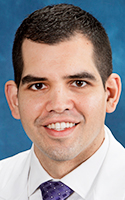One in every four deaths in the U.S. is caused by heart disease, considered one the most preventable health ailments
By Ernst Lamothe Jr.

While it remains one of the most preventable health ailments, heart disease continues to be the leading cause of death, disability and healthcare spending in the United States for men and women.
About 610,000 people die of heart disease in the United States every year — that’s one in every four deaths, according to the Centers for Disease Control and Prevention.
Heart disease is focused on coronary arteries which supply the heart with blood. The most common type of heart disease in the United States is coronary artery disease, which affects the blood flow to the heart. Patients can develop plaque build up, which affects arteries and blocks flow to the heart.
“Because heart disease is the No. 1 cause of death in the developing world this is something that I am passionate about,” said Andrew Mathias, a board-certified cardiologist at UR Medicine in Rochester. “It leads to heart disease, heart failure and billions of dollars in health care costs. But outside of anything I can do as a physician, there are so many simple ways to prevent heart disease that many people who have the ailment just don’t do.”
Mathias offers five tips to a healthier heart.
1. Avoid tobacco
Cigarette smoking is the leading cause of preventable disease and death in the United States, accounting for more than 480,000 deaths every year, or about one in five deaths, according to the CDC. For years, smoking figures declined. However with the advent of e-cigarettes, smoking has stormed its way to the forefront.
“Smoking is very well documented as causing adverse health outcomes that can lead to heart disease, stroke and cancer,” said Mathias.” If I have a patient who smokes, I tell them that that nothing reduces the chances of heart attacks more than just stopping smoking. Studies show that someone who stops smoking for five years can reduce the level of a heart attack to the level of someone who is a nonsmoker.”
2. Maintain normal weight
Being overweight continues to be a risk factor for heart disease and stroke. Keeping your heart healthy by making healthier food choices isn’t as hard as it sounds. Some of the standard tips Mathias suggests include choosing healthy fats such as avocados as well as omega-3 fatty acids found in nuts, seeds, tuna and salmon. In addition, whole-grain breads or pastas are higher in fiber and complex carbohydrates. Choose them instead of white breads or regular pastas for sandwiches and meals.
“Obesity is something very common in most of my patients that come through with any heart related issues,” said Mathias. “The body is not designed to have 50 to 100 extra pounds. It can lead to diabetes and wreak havoc to your vascular system.”
3. Eat fruits and vegetables
Fresh, filling and heart-healthy, fruits and vegetables are an important part of your overall healthy eating plan.
They are high in vitamins, minerals and fiber and low in fat and calories, according to the American Heart Association. Eating a variety of fruits and vegetables may help you control your weight and your blood pressure.
“The general wisdom that your mom told you about growing up is true. Eating fruits and vegetables can have a significant impact,” added Mathias.
4. Exercise regularly
One of the very best gifts you can give your heart is physical activity. Even something as small as parking your car at the far end of a parking lot or choosing the stairs rather than the elevator can make a world of difference. Exercising lowers your blood pressure and works to slow your heart rate. High pressure is a major risk factor for heart disease. Being physical also is a necessary step to losing weight and keeping the weight off which also puts less pressure on your heart. Mathias suggests body mass index as one of the key indicators to weight. He recommends a BMI less than 25.
Mathias said the American College of Cardiology and American Heart Association recommend 30 minutes of moderate exercise five times per week which can include a brisk walk.
5. Check your blood pressure
When your heart beats, it pumps blood around your body to give it the energy and oxygen it needs. As the blood moves, it pushes against the sides of the blood vessels. The strength of this pushing is your blood pressure. If your blood pressure is too high, it puts extra strain on your arteries and your heart and this may lead to heart attacks and strokes. An average number is 120/80. The first number is your systolic pressure, which is the pressure when your heart is beating. The latter number is the pressure between beats when your heart is resting. “This is something that you should check several times a month especially as you enter your fifth and sixth decade,” said Mathias. “There are times where symptoms might not be apparent but you may still have high blood pressure.”
